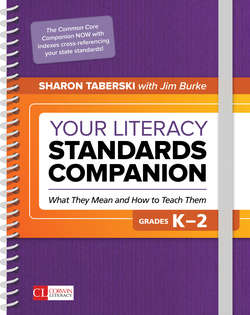Читать книгу Your Literacy Standards Companion, Grades K-2 - Jim Burke - Страница 7
Introduction: Turning Standards Into Daily Teaching
ОглавлениеEvery time we experience a problem, we have the opportunity to gather new resources, think about it, frame it, and take action.
—Renate N. Caine and Geoffrey Caine, Natural Learning for a Connected World
An excellent education should not be an accident; it should be a right, though nowhere in the United States Constitution or any of our other founding documents do we find that right listed. The Common Core State Standards address that omission and challenge us all—administrators and teachers, parents and children, politicians and the public at large, professors and student teachers—to commit ourselves anew to the success of our children and our country.
This is how Jim Burke opened grades 6–8 and 9–12 of The Common Core Companion, the four-volume ELA series he conceived of for Corwin Literacy in 2013. In the 3 years since, these books and the volumes for K–2 and grades 3–5 have been so-called “evergreen” bestsellers, because they help educators everywhere get the important work done of transforming standards into daily learning outcomes. A series for Common Core Mathematics Companion also thrives. Here’s the interesting thing: Corwin sales data showed robust book sales even in states that never adopted the Common Core State Standards (CCSS)—educators were purchasing the books to help them refresh or reimagine their own state standards. When Leslie Blauman, the author of the grades 3–5 version, and I heard of these sales, it made great sense: educators are brilliant at adapting resources to suit their needs. Yet maybe more important, it underscored for us that while the politics and assessments tied to the CCSS are fraught—and Leslie and I knew from the get-go of the CCSS adoption that they would be—the standards themselves are timeless and true to what we want our students to be able to do.
It also didn’t surprise Leslie, Jim, and me when Corwin Literacy saw this market need and decided to issue this new version, Your Literacy Standards Companion, with indexes for each state that opted out of the CCSS, to make it easier for users to go right to the pages most aligned to their state’s standards. The following states have indexes in this book:
Alaska
Arizona
Arkansas
Colorado
Florida
Georgia
Indiana
Iowa
Kansas
Louisiana
Maryland
Minnesota
Mississippi
Missouri
Nebraska
New Jersey
Oklahoma
Pennsylvania
South Carolina
Tennessee
Utah
Virginia
West Virginia
As I write this revised introduction and reflect on how any standards are best put into practice, my advice to you on how to use this resource is twofold: first, overall I would use the “What to Teach” pages as springboards to planning curriculum and deciding upon instructional methods you want each grade level teacher to use. The authors of the CCSS shared the “what,” but it’s up to us to understand the “why” and provide the “how.” Second, I would recommend that you view the standards and this companion from the vantage point of your students’ needs and readiness and make adjustments accordingly. For example, there may be times when you should refer to the standards for an earlier grade because your students are more aligned with those skills and behaviors. At other times, you’ll feel the need to advance instruction and look at the grade level ahead of the grade you teach. Both decisions are yours to make. The CCSS are guidelines and a wonderful resource for teachers whether or not your state has formally adopted them. It’s we educators, assigned with the responsibility of making the day-to-day decisions regarding what to teach, who get to plan the teaching and learning experiences that bring any standard to life.
